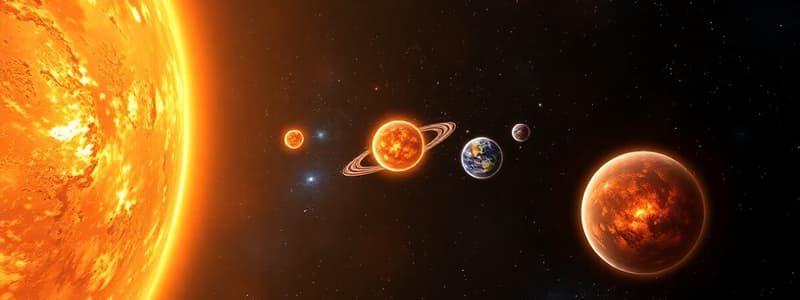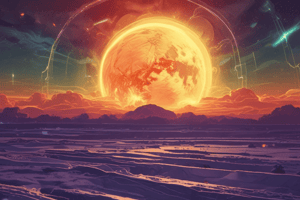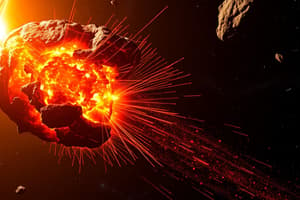Podcast
Questions and Answers
What is the first stage in the life cycle of a star?
What is the first stage in the life cycle of a star?
- Nebula (correct)
- Red giant
- White dwarf
- Main sequence star
A protostar is formed before nuclear fusion occurs.
A protostar is formed before nuclear fusion occurs.
True (A)
What happens to a star after it enters the red giant phase?
What happens to a star after it enters the red giant phase?
It becomes a planetary nebula and then a white dwarf.
The life cycle of a solar mass star concludes with a ____ dwarf.
The life cycle of a solar mass star concludes with a ____ dwarf.
Which of the following stages does NOT occur in the life cycle of a solar mass star?
Which of the following stages does NOT occur in the life cycle of a solar mass star?
During the main sequence stage, a star is in a state of instability.
During the main sequence stage, a star is in a state of instability.
Match the following stages of a solar mass star's life cycle with their descriptions:
Match the following stages of a solar mass star's life cycle with their descriptions:
What causes a star to become a red giant?
What causes a star to become a red giant?
Flashcards
Nebula
Nebula
A giant interstellar cloud of gas and dust from which stars are born.
Protostar
Protostar
A hot ball of gas that forms when gravity pulls particles in a nebula closer together.
Main Sequence Star
Main Sequence Star
The stage when a star begins to fuse hydrogen into helium in its core, releasing energy and shining brightly.
Red Giant
Red Giant
Signup and view all the flashcards
Planetary Nebula
Planetary Nebula
Signup and view all the flashcards
White Dwarf
White Dwarf
Signup and view all the flashcards
Nuclear Fusion
Nuclear Fusion
Signup and view all the flashcards
Stellar Equilibrium
Stellar Equilibrium
Signup and view all the flashcards
Study Notes
Star Life Cycle (Solar Mass Stars)
- Stars begin as a nebula, a giant cloud of gas and dust.
- Gravity pulls particles in a nebula closer together, forming a protostar.
- Density increase, frequent particle collisions lead to a rising temperature in the protostar.
- Nuclear fusion reactions ignite within the core of a protostar, turning it into a main sequence star.
- A main sequence star is stable due to the equilibrium between gravity and outward pressure from fusion.
Main Sequence to Red Giant
- Hydrogen fuel in the core of the star gradually depletes after billions of years.
- Core fusion slows down, and the core contracts.
- The outer layers of the star expand dramatically.
- This expansion cools the star's surface, turning it into a red giant.
Red Giant to White Dwarf
- Helium fusion starts in the core of the red giant.
- Eventually, helium fuel runs out, resulting in the star collapsing.
- The star sheds its outer layers, forming a planetary nebula.
- The remaining core, a very hot but small object, is known as a white dwarf.
- The white dwarf gradually cools over time.
Studying That Suits You
Use AI to generate personalized quizzes and flashcards to suit your learning preferences.
Description
Explore the fascinating journey of solar mass stars from their formation in a nebula to their final stages as white dwarfs. This quiz covers key processes like nuclear fusion, expansion into red giants, and the formation of planetary nebulae. Test your knowledge on the stages of stellar evolution!




